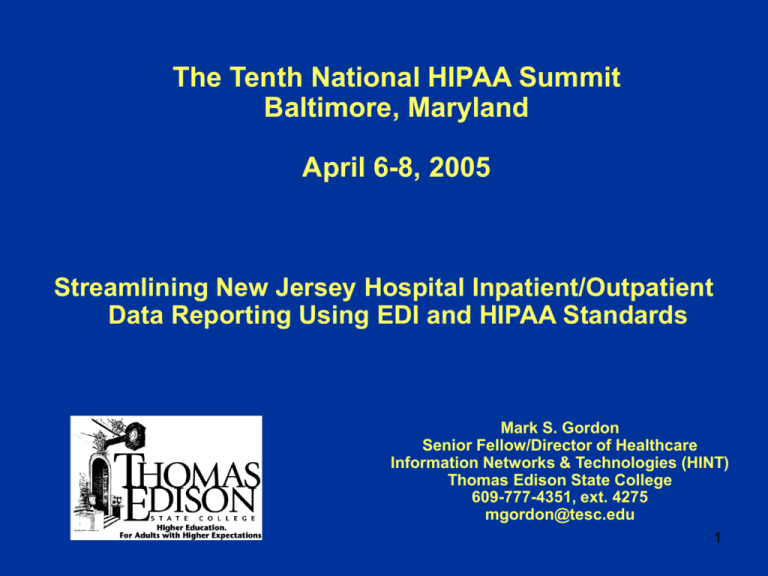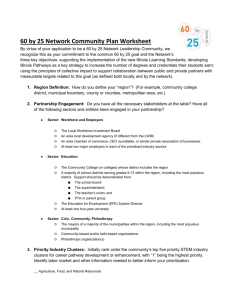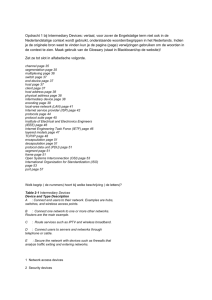NJ Regulations for Collection of UB
advertisement

The Tenth National HIPAA Summit Baltimore, Maryland April 6-8, 2005 Streamlining New Jersey Hospital Inpatient/Outpatient Data Reporting Using EDI and HIPAA Standards Mark S. Gordon Senior Fellow/Director of Healthcare Information Networks & Technologies (HINT) Thomas Edison State College 609-777-4351, ext. 4275 mgordon@tesc.edu 1 Data Intermediary Project Team • New Jersey Department of Health and Senior Services (NJDHSS) Initiates a major re-engineering project to improve the data intermediary reporting system by using current technology to reduce costs and improve the accuracy, timeliness and accessibility of hospital data. • Thomas Edison State College Project Administrator - Assisted in development of and issued RFP for Data intermediary. On behalf of NJDHSS, award and monitor contracts for Deloitte Consulting and QuadraMed Corporation. • Deloitte Consulting Professional consultant and technical assistance for RFP and QuadraMed Corporation design and implementation of new data intermediary system. • QuadraMed Corporation Based on a public bid, vendor selected to design, implement and maintain new data intermediary system. 2 Background • Medical Incident Data System (MIDS) had collected inpatient discharge data information from acute care hospitals by New Jersey Department of Health and Senior Services (NJDHSS) since the early-1980’s. • Horizon Blue Cross/Blue Shield of New Jersey, as the MIDS data intermediary, collected 1.5 million inpatient and same-day surgery discharge data information annually on behalf of NJDHSS. • The Data Intermediary Project is an outgrowth of the Health Information Networks & Technologies (HINT) study requested by the State Legislature and the Governor to reduce healthcare administrative costs in the state. • The HINT study was a collaborative effort between Thomas Edison State College (TESC) and New Jersey Institute of Technology (NJIT). • The HINT study found that EDI technology and national healthcare transmission standards could achieve $760 million in annual cost savings to New Jersey. 3 Background (cont’d) • HINT study recommended several pilot projects and legislation to implement the HINT goals. The Data Intermediary Project, formally referred to as the New Jersey Discharge Data Collection System (NJDDCS), is one of those projects. • Thomas Edison State College as Project Administrator, on behalf of NJDHSS, issued a public request for proposal, (RFP) to streamline the current inpatient discharge data processing system. QuadraMed awarded contract. • In addition, New Jersey enacted the HINT Law on July 1, 1999 (Chapter 154, Public Law of 1999). This law promotes the use of EDI technology and national healthcare standards, to achieve administrative simplification and cost efficiencies for the public and private sectors in New Jersey. 4 HINT Study Findings Annual Healthcare Expenditure Costs & Claims Processed National New Jersey Total Costs $1 Trillion $30 Billion Administrative Costs $183 Billion $ 5 Billion Claims Processed 4.6 Billion 150 Million 5 HINT Study Findings (cont’d) Annual administrative cost savings using electronic data interchange (EDI) and national healthcare transmission standards. EDI Claims Processing $267.0 Million Reducing Claims rejection with EDI $ 23.6 Million Verification of Insurance with EDI $ Decreasing Accounts Receivable with EDI $102.0 Million Other EDI Applications $360.4 Million TOTAL SAVINGS WITH EDI $760.0 MILLION 7.0 Million 6 NJDHSS Specific Project Goals • Overall simplification of the current Medical Incident Data System (MIDS) • Use existing EDI claims processing and telecommunications technologies using national standards to collect hospital inpatient data • Significantly reduce the per record hospital transaction cost • Provide annual savings for hospitals over the current system • Improve the timeliness, accuracy, and availability of the hospital data • Improve completeness of data by starting to collect outpatient information in the next couple of years 7 NJDHSS Major Objectives • Daily submission by hospital of patient discharge data vs. monthly submissions • Utilize an electronic process consistent with claims submission to Medicare and other payers • Engage the data intermediary vendor as the NJDHSS agent in an electronic commerce transaction. NJDHSS is the same as a payer, except DHSS does not make payments on the billing information. • Enhance the hospital’s ability to submit a clean UB-92 ANSI 837 format to DHSS, resulting in the hospital to comply with the HIPAA claim transaction requirements. • Significantly reduce the $1.26 per transaction record cost to the hospital. • Issue the ANSI 837 implementation guide addendum. 8 Data Intermediary Project Benefits Collect on a daily basis health care inpatient discharge data on 1.5 million patients treated in New Jersey hospitals, and to yield accurate, up-to-date and comprehensive data. Expand data collection to include outpatient data on an additional 14.5 million patients annually. Expected to save the hospital industry millions of dollars. Based on QuadraMed bid, the hospital transaction costs alone will decrease by 60%. New system provides hospital with up-front edits and electronic submissions to the data intermediary on a daily basis, versus current monthly mailed tape. Use 128-bit encryption for data transmissions over the Internet which meet the HIPAA security requirement. Uses ANSI X12N - 837 Version 4010i format required by HIPAA. 9 Current MIDS process NJ DHSS/QuadraMed process The host system The host system creates a monthly tape for submission to Blue Cross (by mail) creates a daily file and downloads it to a network server accessible by the QEDI data collection pc ANSI 837 format Tape An edit template is The hospital’s MIDS applied to the daily file at the hospital by the QEDI software to indicate claims in error. These claims are corrected in a timely fashion coordinator edits the records based on the “turn around” documents and the process repeats until all records are deemed clean. Only clean claims are Blue Cross applies edits to the data and produces “turn around” documents highlighting claims in error. transmitted to the QuadraMed Claims Network Center (via Internet or analog transmission). Clean Claims Blue Cross Internet QuadraMed accepts the Turn around document clean claims and makes them available for reporting over the Internet to both NJDHSS and hospitals 10 QuadraMed Claims Network Center Current MIDS process NJ DHSS/QuadraMed process The host Blue Cross system creates a daily file and downloads it to a network server accessible by the QEDI data collection pc then sends tape by mail to NJ DHSS. NJ DHSS sends tape to NJ State Office of Information and Technology(OIT). OIT processes tape and then generates error report and tape. ANSI 837 format Tape An edit template is applied to the daily file at the hospital by the QEDI software to indicate claims in error. These claims are corrected in a timely fashion OIT sends error Only clean claims are report and tape to Blue Cross for hospital corrections. Hospital corrections sent to Blue Cross and forwarded to DHSS. transmitted to the QuadraMed Claims Network Center (via Internet or analog transmission). Blue Cross Clean Claims Internet QuadraMed accepts Turn around document the clean claims and makes them available for reporting over the Internet to both DHSS and hospitals. QuadraMed Claims Network Center 11 NJ DHSS/QuadraMed process The host system creates a daily file and downloads it to a network server accessible by the QEDI data collection pc ANSI 837 format Uses HIPPA transaction standard 837 version 4010i An edit template is applied to the daily file at the hospital by the QEDI software to indicate claims in error. These claims are corrected in a timely fashion Only clean claims are transmitted to the QuadraMed Claims Network Center (via Internet or analog transmission). Online upfront edit Clean Claims Internet QuadraMed accepts the clean claims and makes them available for reporting over the Internet Eliminates need for “turn around” documents Utilizes Internet technology for data transmissions and access using 128 bit encryption. Meets HIPAA security standard QuadraMed Claims Network Center 12 NJDHSS Pilot Evaluation Process • A post implementation report was prepared by the NJDHSS project team. • The success of the pilot was measured in 4 specific areas (1) System Evaluation (2) Cost (3) Process Improvement (4) Customer Satisfaction 13 NJ Regulations for Collection of UB-92 Data Description Existing New NJDDCS Reporting requirement to submit a final bill to the data intermediary 30 days after discharge Same Hospital data submission to the data intermediary Various – weekly, monthly Daily – discharge billed previous day Time limit for hospitals to correct edit rejects from data intermediary 5 working days 2 working days Time limit for data intermediary to submit to DHSS Within 90 days of end of quarter – for all discharges during quarter 5 days after end of month – for all patients billed previous month Notification of database closure 30 days notice of intent to close database must be provided by DHSS Same Earliest database can be closed Within 90 days after calendar year end No sooner than 90 days after calendar year end Penalty for records submitted after database closure $10.00 per record $1.00 per record per day 14 Summary of NJDDCS and MIDS System Comparisons NJDDCS MIDS •Modified UB and 837 4010i file formats for data streams (industry standards) •Proprietary MIDS file format. •Edit report available daily at the client desktop •Edits only available on turnaround documents sent via US Mail after data submissions. •User friendly, PC based editing software using latest EDI software. •Mainframe terminal based editing software. •Data transmitted via Internet or direct dial. •Data sent on mainframe tapes and cartridges via US Mail. •Data available to the hospital within 24-48 hours of transmission. •Data available one week or more after submission •Data available to the State within 24-48 hours of transmission. •Data available to the State 90 days after Quarter ends. •$0.50 per record cost for submission. •$1.26 per record cost for submission. •Data is available to hospitals on 3480 cartridges, CD-ROM, and for free via Internet. •Data is available only on mainframe tapes or cartridges. 15 Emergency Room Data Collection • NJDHSS received approval October 2003 to expand data collection to include emergency department (ED) electronic data collection. • Emergency Room Data Collection expanded to include identification of potential bioterrorism cases. • Phase I included generation of automatic nightly email for notification to the DHSS based on identification of specific codes in the patient data. • Phase II included a data base query tool which includes access to all cases rather than specific diagnoses. • Reporting accomplished through an automated secure file transfer protocol (FTP) connection during Summer 2004. • ED outpatient data collection more than doubles the amount of inpatient data collected by DHSS (2.4 million ED vs. 1.5 million inpatient). 17 Data Intermediary Project Summary • Five pilot hospitals participated. All reported process and system improvements along with reduced costs. • State data intermediary regulation changes proposed on March 16, 2000; regulations approved by State Health Board Advisory Council on July 20, 2000. Regulations adopted on August 21, 2000 in New Jersey Register. • Roll-out includes pre-implementation meeting; file certification; user training; installation; and data transmission. • New NJDDCS is installed at all 89 NJ acute care hospitals; complete installation by 6/31/01. • Project is meeting HIPAA requirements; also on time and within budget. 18 Data Intermediary Project Summary (cont’d.) • Achieved major objectives of the data intermediary project: • Use EDI to daily transmit hospital data w/upfront edit • Eliminate turnaround documents • Accurate, timely, and accessible hospital data via Internet • Closeout NJDHSS calendar year end hospital data base within 5 months instead of current 12-18 months • Hospital transmission costs reduced 60% to $0.50, savings of $1.5 million annually • In January 2000 first state project in the nation to have ANSI X12N-837 version 4010i, a HIPAA standard, certified as compliant by the Electronic Health Network Accreditation Commission (EHNAC) 19 Biography Mark S. Gordon Mark S. Gordon, Senior Fellow/Director of Healthcare Information Networks & Technologies (HINT) at Thomas Edison State College (Trenton, NJ), is the College’s team leader for the Healthcare Information Networks and Technologies (HINT) study and implementation efforts. Under his leadership, the first statewide healthcare survey in the nation was conducted on the use of current information technologies, associated costs, and barriers to the use of information technology. Based on the HINT study recommendations, New Jersey legislation has been signed into law [P.L. 1999, Chapter 154] on July 1, 1999 to promote healthcare EDI and administrative simplification using HIPAA standards. Mark has over twenty years of senior level public sector experience and has served on various boards, commissions, and workgroups at the local, state and national levels. The New Jersey HINT Study is available by sending a $30 check payable to Thomas Edison State College to the address on PowerPoint title page. 20





